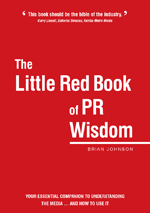 This guest post is an excerpt from The Little Red Book of PR Wisdom, written by Brian Johnson of Australia, an award-winning journalist, a former news director, on-air presenter, producer, narrator, foreign correspondent and documentary maker, who has worked for radio, television, magazines, newspapers and websites. He has provided editorial PR services to a diverse range of leading organisations in the private and public sector including “60 Minutes,” Penthouse magazine, Lifeline to the National Trust. The Little Red book of PR Wisdom, 260 pages, is $34.95 delivered, and the ebook is $11.99.
This guest post is an excerpt from The Little Red Book of PR Wisdom, written by Brian Johnson of Australia, an award-winning journalist, a former news director, on-air presenter, producer, narrator, foreign correspondent and documentary maker, who has worked for radio, television, magazines, newspapers and websites. He has provided editorial PR services to a diverse range of leading organisations in the private and public sector including “60 Minutes,” Penthouse magazine, Lifeline to the National Trust. The Little Red book of PR Wisdom, 260 pages, is $34.95 delivered, and the ebook is $11.99.
* * *
By Brian Johnson
 Who are you offering up for interview?
Who are you offering up for interview?
If possible, it’s a good idea to have two contacts on your press release or pitch.
Sometimes the media will phone and want to do the interview then and there. If you’ve only got one option, that person may not be available.
You might think it unreasonable not to be given notice. But you have put out a media release and the person you have nominated is, by definition, available for the interview.
Also, if you’re distributing releases on a regular basis, try not to offer the same person (it may be your boss) over and over. Too often, deep inside the media organisation you’re trying to crack, you will hear, “Oh, we spoke to him last week,” as your release gets rejected.
Have someone else on tap. If there’s an expert who fits your material, see if he or she is happy to be interviewed as well.
PR people can become paranoid about “owning” the topic and making sure they get their plugs in during the interview. They feel that by offering up an outside expert, their own organisation might not get the credit deserved.
Every so often, you get coverage where the credit isn’t forthcoming, and this can come to be seen as the paranoid norm. It’s not true.
If the media are doing the story, they will instinctively let the audience know where it comes from, so you’ll get your plug in.
And keep in mind that it’s about giving the media the story they want so you can get coverage in the first place.
The clincher is to link your organisation to the information as exclusively as possible – as the source of the information – and then offer the best interview options.
Otherwise you’ll be left to wonder why no one called, because you alone are convinced this was a better topic than the last one.
Give the media options and avoid the one-spokesperson-fits-all approach.






Very Good Advise. Sometimes people forget those “KEY” things when doing an interview or when promoting. Thank you for sharing!
Diane, Brian’s guest post is a fabulous reminder that offering only one spokesperson can become tiresome for reporters who cover that company regularly. Thanks for commenting.
I guess this is also an opportunity to involve someone else in your network. I am often out with a client but know a tremendous VA who has joined me in my exercise sessions and shiatsu therapy.
If I put her name on the press release as well as mine there will surely be a win-win situation. If I’m available I can talk directly to the contact. If my VA takes the call she will present my work as a client and also become known to the media outlet. That’s correct isn’t it?
Ernie, I don’t think that your idea is what Brian is referring to. I took it to mean you should offer two or more people, the same company, as media spokespersons. If you’re out with a client and a reporter calls, but you don’t have time for the interview and you work for yourself, return the call as soon as you can and ask the reporter if you can set up a time later that day to talk. Usually, they will be willing to wait if they know you’re a good source.
At the end of the interview, you can offer the contact info for the VA. You don’t want the reporter to think the VA is representing your company.